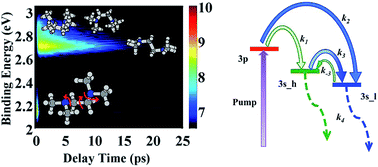Ultrafast structural dynamics in Rydberg excited N,N,N′,N′-tetramethylethylenediamine: conformation dependent electron lone pair interaction and charge delocalization†
Abstract
Two nitrogen atoms and a flexible carbon skeleton make N,N,N′,N′-tetramethylethylenediamine (TMEDA) an important model system to study the interplay of conformeric motions and charge delocalization. Ionization of one of the nitrogen atoms generates a localized charge that may (partially) transfer to the other nitrogen. The structural motions, conformation dependent electron lone pair interaction and charge transfer in Rydberg-excited TMEDA, where the molecular ion core closely resembles the ion, were probed by time-resolved Rydberg fingerprint spectroscopy. Excitation to the 3p Rydberg level with a 209 nm laser pulse initially created a charge-localized ion core. Rapid internal conversion to the 3s Rydberg state yielded a multitude of conformational structures, in particular structures that are close to the folded GG′G+ and GGG′+ (see text for label definitions) core structures (235 fs), and structures that are close to the extended TTT+ core structure (557 fs). The initial excitation and the internal conversion deposit about 1.89 eV of energy into the vibrational manifold, enabling a fast equilibrium between the folded and the extended structures. The forward and backward time constants were determined to be 490 fs and 621 fs, respectively. With the molecule highly vibrationally excited, the decay to 3s proceeds with a 6.77 ps time constant. Density functional theory (DFT) and ab initio calculations show evidence of strong lone pair interaction and charge delocalization in the equilibrium conformers. Importantly, DFT with self-interaction correction properly describes the binding energy of the Rydberg electron and provides excellent agreement with the experimental results.


 Please wait while we load your content...
Please wait while we load your content...